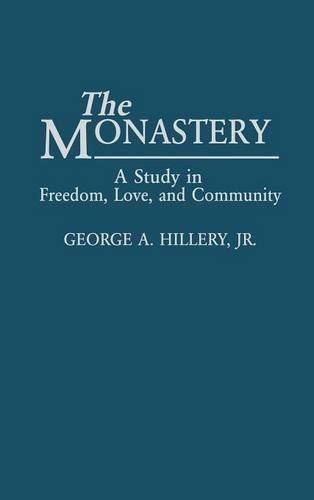
The Monastery: A Study of Freedom, Love, and Community
(Hardback)
Publishing Details
The Monastery: A Study of Freedom, Love, and Community
By (Author) George A. Hillery
Bloomsbury Publishing PLC
Praeger Publishers Inc
30th July 1992
United States
Classifications
Tertiary Education
Non Fiction
Christianity
Religious communities and monasticism
Anthropology
255
Physical Properties
Hardback
328
Description
Monasteries are one of the few types of communities that have been able to exist without the family. In this first-hand study of the daily life in a Trappist monastery, Hillery concludes that what binds this unusual and highly successful community together is its emphases on freedom and agape love. "The Monastery" reintegrates sociology with its allied disciplines in an attempt to understand the monastery on its own terms, and at the same time link that with sociology. Hillery delves into the history, the importance of the Rule of Benedict, the strictness of the Trappist interpretation, and the significance of the Second Vatican Council. Throughout, he uses a holistic anthropological approach. The work begins with a detailed sociological analysis of freedom, love, and community. Other topics include ways in which candidates enter the monastery, their relation to their families, economic activities, politics, prayer, asceticism, recreation, illness, death, and deviance. Comparisons are made with nine of the other 11 Trappist monasteries in the United States. Anthropologists and sociologists, especially those interested in community, comparative analysis, and religion may be challenged by "The Monastery" to move beyond the arbitrary limits they have placed on themselves, which maintain that all knowledge must be capable of being physically perceived and statistically measured.
Reviews
Hillery, a sociologist and a Protestant, engaged in participant observation in Trappist monasteries (especially one which he gives the fictitious name of Our Lady of the Palisades) from 1969 to 1984, and less formally to the present. After setting his fictional abbey in historical and sociological context, Hillery gives an ethnographic analysis which shows the importance of obedience, freedom, and love to its community bonding and functioning. Hillery highlights how the monastery's views about work (economic productivity does not necessarily bring prestige), sickness (viewed as an opportunity to become a real monk), and death contribute to the sense of community. This fascinating and perceptive study is geared especially to sociologists, but should appeal to a wider interest. Recommended for academic, seminary, and large public libraries.-Library Journal
The major contributions of Hillery's book are a detailed description of life in the monastery, with emphasis upon the central motivating force of agape love, and the development of a theory of communal organization that predicts the success of communal endeavors. The book, therefore, is important both for scholars of religion interested in the monastery as one form of religious expression and for sociologists interested in types of formal organizations. Hillery's book is a major contribution to the evolving literature on communes and new religious movements, particularly the attempt to understand why some groups, like Catholic monasteries, survive for centuries, while others do not.-Contemporary Sociology
"The major contributions of Hillery's book are a detailed description of life in the monastery, with emphasis upon the central motivating force of agape love, and the development of a theory of communal organization that predicts the success of communal endeavors. The book, therefore, is important both for scholars of religion interested in the monastery as one form of religious expression and for sociologists interested in types of formal organizations. Hillery's book is a major contribution to the evolving literature on communes and new religious movements, particularly the attempt to understand why some groups, like Catholic monasteries, survive for centuries, while others do not."-Contemporary Sociology
"Hillery, a sociologist and a Protestant, engaged in participant observation in Trappist monasteries (especially one which he gives the fictitious name of Our Lady of the Palisades) from 1969 to 1984, and less formally to the present. After setting his fictional abbey in historical and sociological context, Hillery gives an ethnographic analysis which shows the importance of obedience, freedom, and love to its community bonding and functioning. Hillery highlights how the monastery's views about work (economic productivity does not necessarily bring prestige), sickness (viewed as an opportunity to become a real monk), and death contribute to the sense of community. This fascinating and perceptive study is geared especially to sociologists, but should appeal to a wider interest. Recommended for academic, seminary, and large public libraries."-Library Journal
Author Bio
GEORGE A. HILLERY, JR. is Professor of Sociology at Virginia Polytechnic and State University. He has spent forty years researching communities, and has published several studies on the topic, including A Research Odyssey: Developing and Testing a Community Theory and Communal Organizations: A Study of Local Societies.
